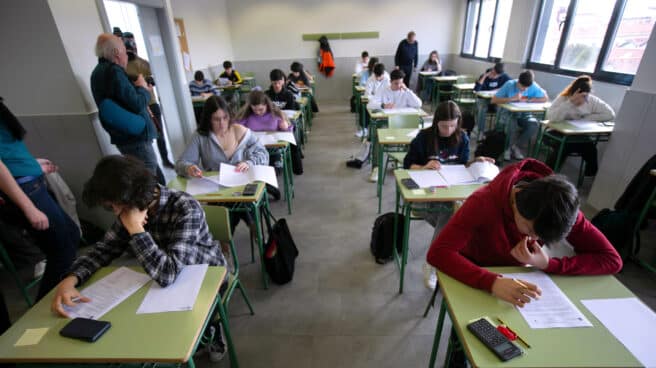

1st class undergraduate students of the Instituto Calderón de la Barca in Gijón take the PAU pilot test
PISA report disqualifies Spanish students from studying reading And mathematicswho thus obtain their worst result in history, while in the science they are improving.
In particular, the Program for Integrated Student Assessment (PISA) 2022 report, prepared every three years by the Organization for Economic Co-operation and Development (OECD), compiled by Europa Press, shows that in mathematics, Spanish students scored 473 points, their worst score in the history of the report (since 2003 they have always received at least 480 points) and 8 points less than in 2018 when they scored 481 points.
In Reading, Spanish students scored 474 points, down 3 points from 2018’s 477, although 13 points higher than their worst historical PISA score of 461 in 2006.
However, in the latest PISA report, which was delayed by a year due to the Covid-19 pandemic, Spain improved its results in science, a subject in which it scored 485 points, up 2 points from 2018 (483 points). . points), a year in which it received its worst result in the history of the report.
Spain’s results in the PISA 2022 report: similar to the OECD average, since the average result of all countries considered is 472 in mathematics (15 points less compared to 2018); 476 in Reading (down 10 points on 2018); and 485 in natural sciences (2 points less than in 2018).
The PISA report, which Spain first participated in in 2000, assesses the knowledge and skills of fifteen-year-old students in mathematics, reading and science and provides information on how education systems prepare students for real-world challenges and academic success. future.
In 2022, approximately 690,000 students took the test, representing 29 million fifteen-year-old schoolchildren in 81 participating countries. In Spain, 30,800 students took part in 966 schools, representing 459,000 fifteen-year-old Spanish schoolchildren.
The OECD report sets six levels based on student performance. Thus, at levels 5 and 6 there are students with high abilities; at levels 3 and 4 – students with average abilities; at level 2 – students with basic abilities; and at level 1 – students with low academic performance.
73% have basic math skills
In Spain, 73% of students achieved at least level 2 in mathematics, more than the OECD average of 69%. At a minimum, these students can interpret and recognize, without direct instruction, how a simple situation can be represented mathematically, such as comparing the total distance between two alternative routes or converting prices to another currency.
The research also shows that around 6% of students in Spain were outstanding students in mathematics, meaning they achieved level 5 or 6 in this test, three percentage points less than the OECD average of 9%. At these levels, students can solve complex situations mathematically and select, compare, and evaluate appropriate strategies for solving related problems.
Relatively Reading76% of students in Spain achieved level 2 or above, two percentage points more than the OECD average of 74%. At a minimum, these students can identify the main idea in a text of moderate length, locate information based on explicit, although sometimes complex, criteria, and can reflect on the purpose and form of texts when explicitly instructed to do so.
In Spain, 5% of students scored at level 5 or above, compared with an OECD average of 7%. These students can comprehend long texts, access abstract concepts, and differentiate between facts and opinions based on implicit cues related to the content or source of information.
ABOUT Science79% of Spanish students achieved level 2 or above, compared to the OECD average of 76%. These students can, at a minimum, recognize the correct explanation for familiar scientific phenomena and can use this knowledge to determine, in simple cases, whether a conclusion is reasonable based on the data provided.
In Spain, 5% of the students were outstanding students in the sciences.This means they performed at level 5 or 6, compared to the OECD average at these levels of 7%. These students can creatively and independently apply their knowledge of and about science in a variety of situations, including those that are unfamiliar to them.
Low performing students
So, In Spain, 27% of students have low academic performance (below level 2) in mathematics (31% OECD average); 24% have low reading achievement (OECD average 26%); and 21% have low academic performance (OECD average 24%).
Except, 6% of Spanish students are outstanding students (level 5 and above) in mathematics (9% OECD average); 5% are outstanding students in Reading (7% OECD average); and 5% are outstanding students in the sciences (OECD average 7%).
In Spain, socioeconomically advantaged students (top 25% in terms of socioeconomic status) outperformed disadvantaged students (25%) by 86 points in mathematics. This is less than the average difference between the two groups (93 points) in OECD countries. Between 2012 and 2022, the achievement gap in mathematics between the top 25% and the bottom 25% of students from socioeconomic status remained stable in Spain, in line with the OECD average.
They are better at math and better at reading.
The study also found gender differences in student achievement. In particular, it details that in Spain boys were 10 points ahead of girls in math, and girls were 25 points ahead of them in reading.
In Spain, the proportion of students with low achievement in mathematics is the same for boys (27%) and girls (28%). However, in Reading the proportion is higher for boys (20% of girls and 29% of boys scored below level 2 in reading). In terms of outstanding students, the proportion in mathematics is higher among boys (7%) than among girls (4%), while in reading the proportion is higher among girls (6% of girls and 4% of boys). or 6 in reading).
On the other hand, PISA 2022 shows that the average difference in mathematics performance between immigrant and non-immigrant students is 33 points in favor of non-immigrants. In Reading the difference was 32 points.
Source: El Independiente